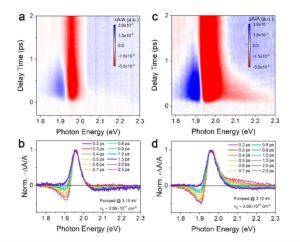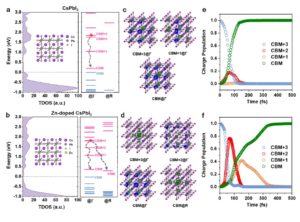Researchers at the Institute of Applied Physics and Materials Engineering of the University of Macau (UM), the Hong Kong Polytechnic University, and King Abdullah University of Science and Technology (KAUST) have, for the first time, realised the regulation of the cooling rate of hot carriers in the CsPbI2Br perovskite films through the strategy of Zn ion doping, which can further improve the light-to-electricity conversion efficiency of the perovskite solar cells. The study has been published in the international journal Angewandte Chemie International Edition, which is a Nature Index journal.
High-quality life in modern society is dependent on the consumption of huge amounts of fossil fuel energy. However, due to limited fossil fuel reserves on earth, the depletion of fossil fuel has become a major concern worldwide. Therefore, the development of high-efficiency renewable energy has emerged as a hot research topic.
Solar cells, also known as ‘solar chips’ or ‘photovoltaic cells’, are photoelectric semiconductor sheets that use sunlight to directly generate electricity. In physics, this is called photovoltaic. Due to the huge amount of solar power that can be developed, it is generally considered as the most likely technology to solve energy crisis in the future. The theoretical limit of photon conversion efficiency (PCE) in traditional single-junction silicon solar cells is ~33.7% (ie Shockley-Queisser Limit), and the energy loss caused by hot carrier relaxation reaches ~33%, while the energy loss in perovskite solar cells is up to ~25%. During the hot carrier relaxation/cooling process in semiconductors, their kinetic energy is usually converted into lattice thermal energy in the form of phonon emission, which leads to the energy loss of light. Therefore, the successful development of a light-absorbing layer with long hot carrier lifetime under sunlight illumination level can facilitate the development of higher-efficiency hot carrier solar cells. It is currently one of the most cutting-edge area in research on carrier dynamics and photovoltaic conversion.
In this study, UM professor Xing Guichuan, PolyU professor Li Mingjie, and KAUST professor Omar F Mohammed studied the cooling and extraction kinetics of hot carriers in Zn-doped CsPbI2Br perovskite films at low carrier injection levels (1017 cm-3). Zn ion doping can significantly reduce defect density and hot carrier cooling rate. Transient absorption spectroscopy measurements demonstrated a three-time reduction of 500-K hot-carrier cooling rate in 0.34% Zn-doped perovskite film compared to the un-doped sample, which enabled successful hot-carrier extraction at the interface of these doped perovskites.
With the help of non-adiabatic molecular dynamics calculations, the slow hot carrier relaxation observed in zinc-doped perovskites can be attributed to the reduction of non-adiabatic coupling between the conduction bands and the additional introduction of zinc dopants, which will delay the relaxation process of photo-generated heat carriers.
澳門大學應用物理及材料工程研究院、香港理工大學和阿卜杜拉國王科技大學(KAUST)以典型的CsPbI2Br鈣鈦礦薄膜為研究物件,首次通過Zn離子摻雜的策略,實現了CsPbI2Br鈣鈦礦薄膜中熱載流子的冷卻速率的調控。該研究能有助於進一步提升鈣鈦礦太陽能電池的效率,已於自然指數期刊《德國應用化學》(Angewandte Chemie International Edition)上發表。
現代高品質的生活是基於大量的化石能源使用,由於化石能源在地球上的儲量有限,人們普遍擔憂化石能源在不久的將來會枯竭。因此高效可再生能源的開發和利用已變成現代社會的研究熱點和難點。太陽能電池,也稱為“太陽能晶片”或“光電池”,是使用陽光直接發電的光電半導體片。因太陽能發電可開發量巨大,普遍被認為是最有可能解決未來能源危機難題的技術。在物理學中,它稱為光伏。傳統單結矽太陽能電池的理論極限光電轉換效率(PCE)為 ~33.7% (即Shockley-Queisser Limit),其中由熱載流子弛豫引起的能量損失達到~33%,在鈣鈦礦太陽能電池中達~25%。半導體中的熱載流子在其弛豫/冷卻過程中,其動能通常以聲子發射的方式轉換為晶格熱能,從而導致光能量的損失。因此開發一種在太陽光照水準下具有長熱載流子壽命的光吸收層,可被用於開發更高效率的熱載流子太陽能電池,是目前載流子動力學及光電轉換研究的前沿領域之一。
澳門大學教授邢貴川、香港理工大學教授李明傑、KAUST大學教授Omar F. Mohammed等研究了在低載流子注入水準(1017cm-3)下Zn摻雜CsPbI2Br鈣鈦礦薄膜中熱載流子的冷卻和提取動力學,發現了Zn離子摻雜可以明顯降低缺陷密度以及熱載流子的冷卻速率。通過瞬態吸收光譜表徵發現,0.34%鋅摻雜鈣鈦礦薄膜中500-K熱載流子冷卻速率比未摻雜樣品降低了三倍,進一步確保了在這些摻雜鈣鈦礦介面上成功進行熱載流子提取。通過非絕熱分子動力學計算,在摻雜鋅的鈣鈦礦中觀察到的緩慢的熱載流子弛豫可以歸因於導帶之間非絕熱偶合的減少以及由鋅摻雜劑引入的額外的弛豫通道,延遲光生熱載流子的弛豫過程。研究成果能有效提高鈣鈦礦太陽能電池的光電轉換效率。
文章的第一作者是澳門大學博士後研究員魏琪和KAUST博士後研究員殷俊。相關研究獲澳門特別行政區科學技術發展基金(檔案編號:091/2017/A2及014/2017/AMJ)和澳門大學(檔案編號:MYRG2018-00148-IAPME)資助。全文可覽:https://onlinelibrary.wiley.com/doi/10.1002/anie.202100099.
瞬態吸收光譜揭示適當濃度鋅摻雜能
有效延緩鈣鈦礦中的熱載流子弛豫
Transient absorption spectroscopy has revealed that
appropriate concentration of zinc doping can effectively delay
the relaxation of hot carriers in the perovskite
非絕熱分子動力學計算鈣鈦礦狀態總密度和能級
Non-adiabatic molecular dynamics calculation of
total density and energy level of perovskite state



